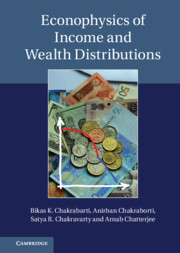Book contents
- Frontmatter
- Contents
- Preface
- 1 Introduction
- 2 Income and wealth distribution data for different countries
- 3 Major socioeconomic modelling
- 4 Market exchanges and scattering process
- 5 Analytic structure of the kinetic exchange market models
- 6 Microeconomic foundation of the kinetic exchange models
- 7 Dynamics: generation of income, inequality and development
- 8 Outlook
- References
- Index
Preface
Published online by Cambridge University Press: 05 May 2013
- Frontmatter
- Contents
- Preface
- 1 Introduction
- 2 Income and wealth distribution data for different countries
- 3 Major socioeconomic modelling
- 4 Market exchanges and scattering process
- 5 Analytic structure of the kinetic exchange market models
- 6 Microeconomic foundation of the kinetic exchange models
- 7 Dynamics: generation of income, inequality and development
- 8 Outlook
- References
- Index
Summary
An imbalance between rich and poor is the oldest and most fatal ailment of all republics.
Plutarch, ancient Greek biographer (c. 46–120 CE)Why does this imbalance exist in the first place? Why are a few rich and many poor? For centuries we have borne the effects of this inequality. We know neither the cause nor the solution to this elusive problem. From philosophers to economists, many have vehemently tried for ages to understand the reasons and formulate remedies for such inequalities. No doubt, great efforts have been made to tackle this multifaceted problem, but the situation has been analogous to fighting the Greek mythological monster Hydra, who grows two heads in place of an injured one. Overcoming this problem, indeed, seems to be a Herculean task!
Heraclitus said, ‘change is the only constant’. Putting our faith in him, one might have expected things to change drastically, and the inequality to even disappear at some point in time! Strangely, this has not been the case. We find that inequality has been a universal and robust phenomenon – not bound by either time or geography. Fortunately for scholars, it has a few statistical regularities, most of which have been recorded in the past 115 years or so. Owing to the seminal works of Pareto (1897) and Gibrat (1931), one can now identify certain regularities in the income and wealth distributions over a wide range of societies and time periods. Physicists have come up with some very elegant and intriguing kinetic exchange models in recent times to shed some light on these observations. Our intention is to describe these developments in this book.
- Type
- Chapter
- Information
- Econophysics of Income and Wealth Distributions , pp. vii - xPublisher: Cambridge University PressPrint publication year: 2013



